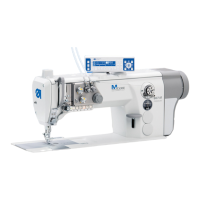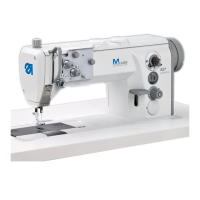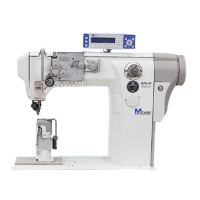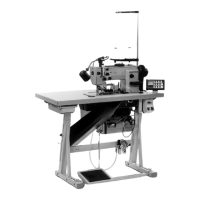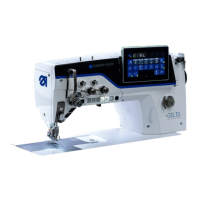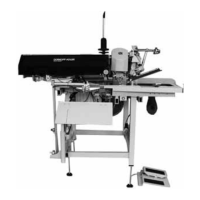What to do if DURKOPP ADLER Sewing Machine shows internal EEprom defective?
- EEdward LeeAug 30, 2025
If the internal EEPROM is defective in your DURKOPP ADLER Sewing Machine, replace the control.
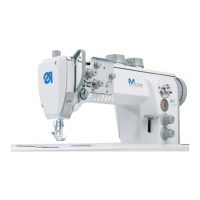






What to do if DURKOPP ADLER Sewing Machine shows internal EEprom defective?
If the internal EEPROM is defective in your DURKOPP ADLER Sewing Machine, replace the control.
What to do if the sewing motor plug (AMP) is not connected on my DURKOPP ADLER 867 Sewing Machine?
If the sewing motor plug is not connected on your DURKOPP ADLER Sewing Machine, check the connection and plug it in if necessary. You may also test sewing motor phases (R= 2.8 ?, high impedance to PE). Replacing the encoder, sewing motor, or the control might also resolve the issue.
Why is my DURKOPP ADLER 867 Sewing Machine showing a low voltage failure?
If your DURKOPP ADLER Sewing Machine shows a low voltage failure (1st threshold), it means the mains voltage is below 180V AC. Check the mains voltage, stabilize it, or use a generator to resolve this issue.
What to do if DACextension box is not responding on DURKOPP ADLER 867 Sewing Machine?
If the DACextension box is not responding on your DURKOPP ADLER Sewing Machine, check the connection cables and the LEDs of the DACextension box. A software update might also be necessary.
What to do if DURKOPP ADLER Sewing Machine shows low voltage warning?
If you're getting a low voltage warning on your DURKOPP ADLER Sewing Machine because the mains voltage is below 180 V AC, you should first check the mains voltage. If it's consistently low, consider stabilizing the mains voltage or using a generator to ensure a stable power supply.
What to do if sewing motor encoder plug (Sub-D, 9-pin) is not connected in DURKOPP ADLER 867 Sewing Machine?
If the sewing motor encoder plug is not connected on your DURKOPP ADLER Sewing Machine, connect the encoder cable to the control using the correct connection.
What to do if DA stepper card 2 is not responding on DURKOPP ADLER 867 Sewing Machine?
If DA stepper card 2 is not responding on your DURKOPP ADLER Sewing Machine, check the connection cables and the LEDs of the DACextension box. A software update might also be required.
How to fix software version error on DURKOPP ADLER 867 Sewing Machine?
If you encounter a software version error on your DURKOPP ADLER Sewing Machine (DAC classic only), try updating the software. If the issue persists, consider replacing the control.
Why is speed limited due to insufficient mains voltage on DURKOPP ADLER 867 Sewing Machine?
If the speed is limited on your DURKOPP ADLER Sewing Machine due to insufficient mains voltage, check the mains voltage.
What to do if DA stepper card 1 encoder plug (Sub-D, 9-pin) is not connected on DURKOPP ADLER 867?
If the DA stepper card 1 encoder plug is not connected on your DURKOPP ADLER Sewing Machine, connect the encoder cable to the control using the correct connection.
| Stitch Type | Lockstitch |
|---|---|
| Max Stitch Length | 12 mm |
| Needle System | 134-35 |
| Needle Thread Tension | Adjustable |
| Lubrication | Automatic |
| Type | Industrial Sewing Machine |
| Max Sewing Speed | 3000 stitches per minute |
| Presser Foot Lift | 20 mm |
| Power Requirements | 230V/50Hz |
Identifies the target audience for the service instructions.
Explains symbols and formatting used for clarity in the manual.
Lists related documentation for further reference.
Outlines the manufacturer's liability limitations.
Provides fundamental safety guidelines for machine operation and maintenance.
Details hazard levels and associated symbols for safety alerts.
Emphasizes adjustment sequence and proper cable routing.
Explains procedures for accessing machine components by removing covers.
Describes shaft features and methods to secure the machine for adjustments.
Instructions for positioning the handwheel to specific marks for adjustments.
Step-by-step guide for recalibrating the handwheel's graduated scale.
Procedure to correctly position the arm shaft for proper machine function.
Instructions for aligning both upper and lower toothed belt wheels.
Detailed steps for adjusting the primary and secondary stitch length controls.
Setting stitch length limits and adjusting for forward/backward stitch consistency.
How to set feed dog position and adjust its movement cycle for accurate feeding.
Setting and adjusting the feed dog's lift height using different methods.
Procedures for aligning the needle bar linkage sideways and in the sewing direction.
Setting hook-needle clearance and synchronizing loop formation.
Adjusting the needle guard and needle bar height for correct needle-hook interaction.
Setting the lifting gap and synchronizing the bobbin case lifter's operation.
Adjusting sewing foot lift height, stroke, and pressure for material.
Fine-tuning the walking foot's movement relative to the feed dog.
Adjusting needle thread tension using the regulator and spring.
Aligning winder components and adjusting the hook thread guide.
Adjusting the winder's operation and determining bobbin fill quantity.
Adjusting knife height and the path of the thread-cutting action.
Setting cutting pressure and synchronizing the thread cutting operation.
Overview, locking latch, thread-pulling knife, counter blade, and timing adjustments for KFA.
Procedure for setting the potentiometer via the control panel.
Attaching the safety clutch and setting its torque for proper disengagement.
Identifies drive components and explains disassembly/assembly procedures.
Procedures for replacing the sewing light fuse and the main printed circuit board.
Details needle bar height and slide adjustments for these machines.
Setup and fine adjustment for machines with a moving binder.
Adjustments for knife movement time, stroke, blade overlap, and cutting edge settings.
How to activate the tensioner lift and Needle Stop Brake (NSB) functions.
Procedures for cleaning the machine and lubricating its components.
Maintenance for operating pressure, water-oil draining, and filter cleaning.
Cleaning the motor fan mesh and checking the toothed belt.
Information on how to obtain a parts list for the machine.
Steps to safely take the machine out of service.
Guidelines for environmentally responsible disposal of the machine.
Contact info for support and interpretation of software messages.
Common sewing issues, causes, and solutions.
Machine's noise levels and technical specifications by subclass.
Maximum operating speeds and requirements for reliable performance.
Electrical schematics and wiring layouts for the machine.
